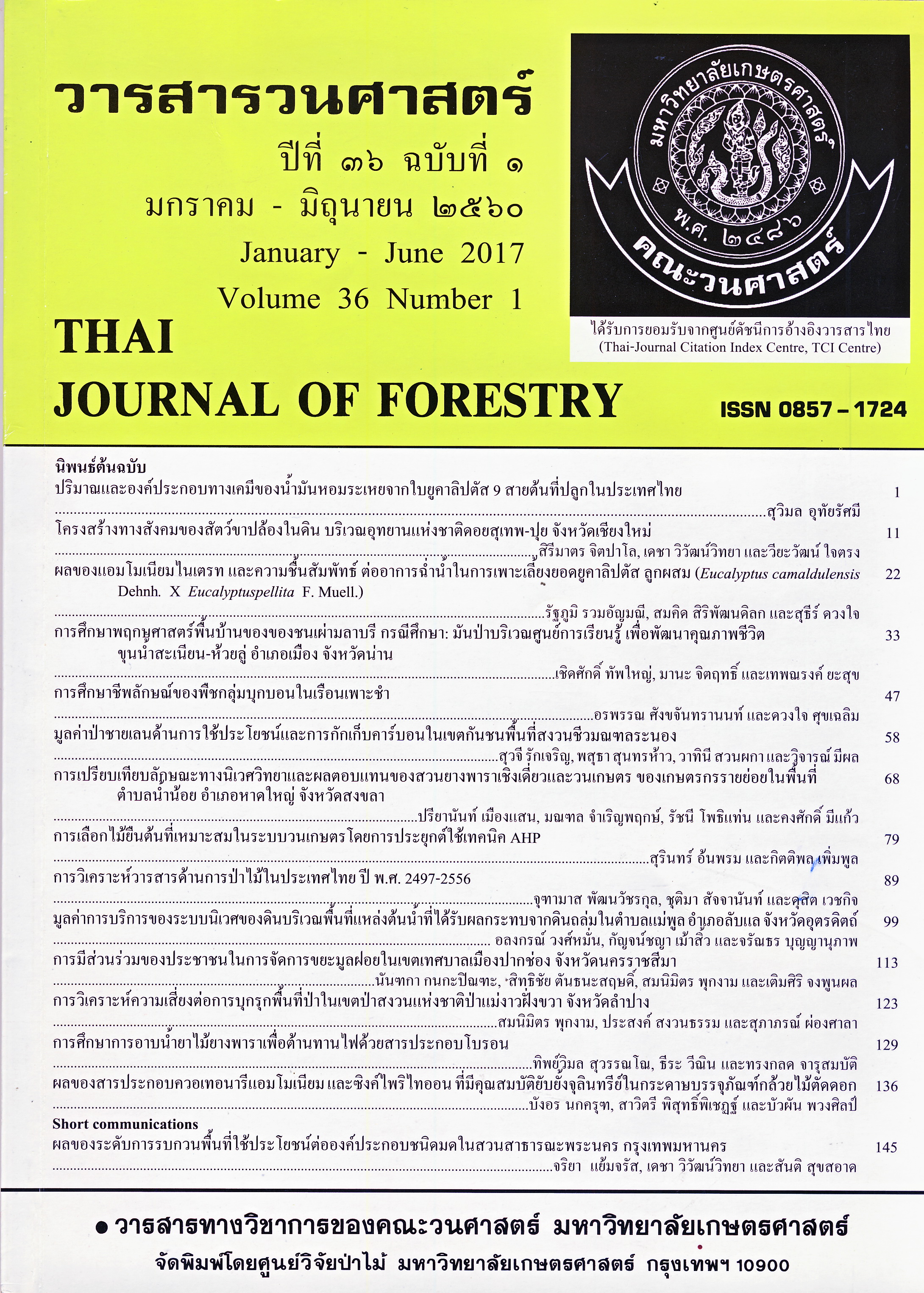ผลของแอมโมเนียมไนเตรท และความชื้นสัมพัทธ์ ต่ออาการฉ่ำน้ำ ในการเพาะเลี้ยงยอดยูคาลิปตัส ลูกผสม (Eucalyptus camaldulensis Dehnh. X Eucalyptus pellita F. Muell.)
Main Article Content
บทคัดย่อ
ในการเพาะเลี้ยงเนื้อเยื่อยูคาลิปตัสลูกผสม มักจะพบปัญหายอดมีอาการฉ่ำน้ำ (hyperhydricity)เป็นประจำ ซึ่งอาการฉ่ำดังกล่าวส่งผลทำให้ยอดไม่แข็งแรง ชักนำให้เกิดรากยาก เมื่อย้ายปลูกจะมีอัตราการรอดตายน้อย โดยปัจจัยหลักที่ส่งผลทำให้เกิดอาการฉ่ำน้ำได้แก่ ปริมาณไนโตรเจน และ ความชื้นสมพัทธ์ในขวดเพาะเลี้ยง จึงได้วางแผนการทดลองแบบแฟคทอเรียล (3x4 in factorial designs in RCBD) โดยปรับปริมาณไนโตรเจนโดยใช้แอมโมเนียไนเตรท 3 ระดับ (82.5, 165 และ 330 มิลลิกรัมต่อลิตร) และปรับความชื้นสัมพัทธ์โดยใช้รูกรองอากาศ 4 ระดับ (0, 1, 2 และ 3 รู) ทำการเพาะเลี้ยงด้วยสูตร MS ดัดแปลง เพื่อเพิ่มปริมาณยอด เก็บข้อมูลความชื้นสัมพัทธ์ในขวดเพาะเลี้ยง อัตราการฉ่ำน้ำและการให้ยอด หลังจากนั้นทำการเพาะเลี้ยงเพื่อชักนำให้ยอดยืดยาว และทำการชักนำให้เกิดราก เก็บข้อมูลอัตราการออกราก จำนวนราก และความยาวราก
จากผลการทดลองพบว่าปริมาณแอมโมเนียมไนเตรทส่งผลต่อความยาวราก และจำนวนรูกรองอากาศส่งผลต่อจำนวนยอด อัตราการฉ่ำ ความชื้นสัมพัทธ์ อัตราการออกราก จำนวนราก ความยาวราก อย่างมีนัยสำคัญยิ่ง โดยเฉพาะความชื้นสัมพัทธ์ และจำนวนยอด จะลดลงเมื่อจำนวนรูกรองอากาศมากขึ้น นอกจากนี้ยอดที่มีอาการฉ่ำน้ำจะไม่เกิดรากหรือเกิดรากแต่ไม่สมบูรณ์ ซึ่งการทดลองที่มีประสิทธิภาพที่สุดได้แก่ ปริมาณแอมโมเนียมไนเตรท 82.5 มิลลิกรัมต่อลิตร และรูกรองอากาศ 2 รู (ความชื้นสัมพัทธ์ 78.66 %) เนื่องจากมีอาการฉ่ำน้ำต่ำและมีปริมาณการเพิ่มยอดที่ดี เมื่อนำไปชักนำให้เกิดรากมีอัตราการออกรากสูง และจำนวนรากมาก นอกจากนี้ ยังสามารถลดต้นทนในการผลิตกล้าไม้ยูคาลิปตสลูกผสมลงได้เนื่องจากใช้ปริมาณแอมโมเนียมไนเตรทลดลงจากสูตรปกติ 1 เท่า
Downloads
Article Details
ข้าพเจ้าและผู้เขียนร่วม (ถ้ามี) ขอรับรองว่า ต้นฉบับที่เสนอมานี้ยังไม่เคยได้รับการตีพิมพ์และไม่ได้อยู่ในระหว่างกระบวนการพิจารณาตีพิมพ์ลงในวารสารหรือสิ่งตีพิมพ์อื่นใด ข้าพเจ้าและผู้เขียนร่วม (ถ้ามี) ยอมรับหลักเกณฑ์และเงื่อนไขการพิจารณาต้นฉบับ ทั้งยินยอมให้กองบรรณาธิการมีสิทธิ์พิจารณาและตรวจแก้ต้นฉบับได้ตามที่เห็นสมควร พร้อมนี้ขอมอบลิขสิทธิ์ผลงานที่ได้รับการตีพิมพ์ให้แก่วารสารวนศาสตร์ คณะวนศาสตร์ มหาวิทยาลัยเกษตรศาสตร์ กรณีมีการฟ้องร้องเรื่องการละเมิดลิขสิทธิ์เกี่ยวกับภาพ กราฟ ข้อความส่วนใดส่วนหนึ่ง หรือ ข้อคิดเห็นที่ปรากฏในผลงาน ให้เป็นความรับผิดชอบของข้าพเจ้าและผู้เขียนร่วม (ถ้ามี) แต่เพียงฝ่ายเดียว และหากข้าพเจ้าและผู้เขียนร่วม (ถ้ามี) ประสงค์ถอนบทความในระหว่างกระบวนการพิจารณาของทางวารสาร ข้าพเจ้าและผู้เขียนร่วม (ถ้ามี) ยินดีรับผิดชอบค่าใช้จ่ายทั้งหมดที่เกิดขึ้นในกระบวนการพิจารณาบทความนั้น”
เอกสารอ้างอิง
Cassells, A. and R. Curry. 2001. Oxidative stress and physiological, epigenetic and genetic variability in plant tissue culture: implications for micropropagators and genetic engineers. Plant Cell Tiss. and Org. 64 (2-3): 145-157
Debergh, P.C. and L. Maene. 1984. Pathological and physiological problems related to the in vitro cultures of plants. Parasitica. 40: 69-75.
Edgard, A.T.P., C.O. Wagner, L.F. Marina, M.B.C. Sonia, S.A. Raul, A.M.S. Eldo, R.C. Carlos and P.B.F. Elizabeth. 2001. Hyperhydricity in in vitro eggplant regenerated plants: structural characteristics and involvement of BiP (Binding Protein). Plant Sci. 160: 857-868.
Franck, T., C. Kevers, T. Gaspar, J. Dommes, C. Deby, R. Greimers, D. Serteyn and G. Deby-Dupont. 2004. Hyperhydricity of Prunus avium shoots cultured on gelrite: a controlled stress response. Plant Physiol. Bioch. 42: 519-527
Gribble, K., J. Tingle, V. Sarafis, A. Heaton and P. Holford. 1998. Position of water in vitrified plants by NMR imaging. Protoplasma 201: 110-114
Grodzinski, B., I. Boesel and K. Horton. 1981. Effect of light and carbon dioxide on release of ethlene from leaves of Xanthium strumarium. Plant Physiol. 67: 272-3.
Kei-ichiro, U., C. Susan and S. Kalidas. 1998. Reduced hyperhydricity and enhanced growth of tissue culture-generated raspberry (Rubus sp.) clonal lines by Pseudomonas sp. Isolated from oregano. Process Biochem. 33 (4): 441-445.
Kozai, T., K. Fujiwara, M. Hayashi, J. Aitken-Christie. 1992. The in vitro environment and its control in micropropagation, pp. 247-282. In Kurata K., Kozai T. (Eds.), Transplant production system, Kluwer Academic Publishers, Dordrecht, The Netherlands.
Lai, C. C., H. M. Lin, H. S. Tsay, S. M. Nalawade and W. Fang. 2005. Hyperhydricity in shoot cultures of Scrophularia yoshimurae can be effectively reduced by ventilation of culture vessels. J. Plant Physiology. 162: 355-361
Manoj, K.Y., A.K. Gaur and G.K. Garg. 2003. Development of suitable protocol to overcome hyperhydricity in carnation during micropropagation. Plant Cell Tiss. 72: 153-156
Read, P.E. 1990. Environmental effects in micropropagations, pp. 95-125. In Ammirato PV, Evan DA, Shrap WR, Bajaj YPS (Eds.), Handbook of plant cell culture, Vol. 5. New York.
Roux, J. J. I.E. and S. J. Van. 1991. Micropropagation and tissue culture of Eucalyptus. Tree Physiol. 9: 435-477.
Sadhy, S., A. Piqueras, E. Hellin and E. Oimos. 2005. Prevention of hyperhydricity in micropropagated carnation shoots by bottom cooling: implications of oxidative stress. Plan Cell Tiss. Org. 81: 149-158
Tornero, O. P., J. Egea, E. Olmos and L. Burgos. 2001. Control of hyperhydricity in micropropagated apricot cultivars. In Vitro Cell. Dev. Biol.- Plant. 37: 250-254.
Whitehouse, A.B., Mark T.R. and G.A. Edward. 2002. Control of hyperhydricity in Eucalyptus axillary shoot cultures grown in liquid medium. Plan Cell Tiss. Org. 71: 245-252.
Zobayed, S.M.A., J. Armstrong and W. Armstrong. 2000. Evaluation of closed system, diffusive and humidity-induced convective throughflow ventilation on the growth and physiology of cauliflower in vitro, Plan cell Tiss. Org. 59: 113-123.
Zobayed, S.M.A., J. Armstrong and W. Armstrong. 2001. Micropropagation of potato: evaluation of closed, diffusive and forced ventilation on growth and tuberization. Ann. Bot. 87: 53-9.


